This is a guest blog from reader Vana2, whose real name is Hank. Today he tells us how to index a barrel to get the pellets centered on the vertical line.
If you’d like to write a guest post for this blog, please email me at blogger@pyramydair.com.
Take it away, Hank.
In Pursuit of Sub-MOA – Barrel Indexing
By Hank Vana2
This report covers:
- Barrel Indexing, what about it?
- Some background for reference…
- Do you need to be concerned about indexing?
- Symptoms of a poorly indexed barrel
- What to do?
- Setting up for indexing
- The first thing is to find where we are
- Re-indexing the bore
- Checking the indexing
- Summary
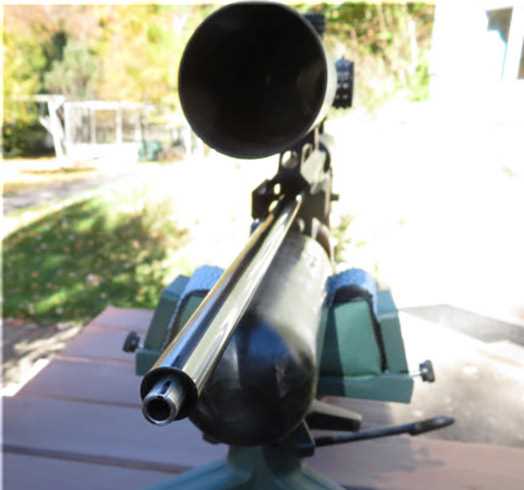
The business-end of an FX Impact with the shroud and retaining nut removed to show the FX Smooth-Twist X barrel liner.
Barrel indexing, what about it?
As much as I enjoy casual off-hand plinking there is a lot of satisfaction in being able to place the shot exactly where I want it at longer ranges. Attention to details and optimum tuning play a large part of the accuracy we all want.
I mentioned barrel indexing as something that I would check in my guest blog “My FX Crown Story” and I’ve since received a couple of emails asking if indexing was necessary and to explain how to go about that. In this blog I’ll try to answer those questions. I recently re-indexed the liner on my Impact and took some pictures to help explain how I went about it.
Theoretically, if barrels were manufactured with their bore perfectly straight and exactly concentric to the barrel there would be no need to index the barrel if it was mounted true to the receiver and sights.
In the real world, there is no such thing as a “perfect” barrel. The chances of forming a very long, small diameter hole concentrically in a steel blank and having it remain straight through subsequent rifling, machining and the (high temperature) bluing process is challenging to say the least. To compensate for manufacturing variances the barrel needs to be indexed. It’s kinda like aligning the wheels on a car.
I’m sure that all reputable manufacturers index the barrels of their airguns so alignment should not be a concern UNLESS someone removes the barrel and doesn’t reinstall it exactly as it was. I’ve been doing a lot of testing with my FX Impact that required swapping back and forth between the “pellet liner” and the “slug liner”. With all this messing about I’ve long since lost the factory indexing and I could see that the rifle was throwing a left hook instead of a straight jab. It was obvious that the barrel was biased incorrectly and needed to be indexed.
Barrel indexing is the procedure where the bias of the bore (the direction it throws the projectile) is aligned with gravity so that the projectile flies in a plane vertical to the point of aim. I think of barrel the barrel bias as the “cant error” in the rifle.
By making a reference mark on the barrel then shooting groups as the barrel is rotated in 90 degree increments we can determine which way the barrel is biased and then adjust the bias so that it is in a vertical plane.
Some background for reference…
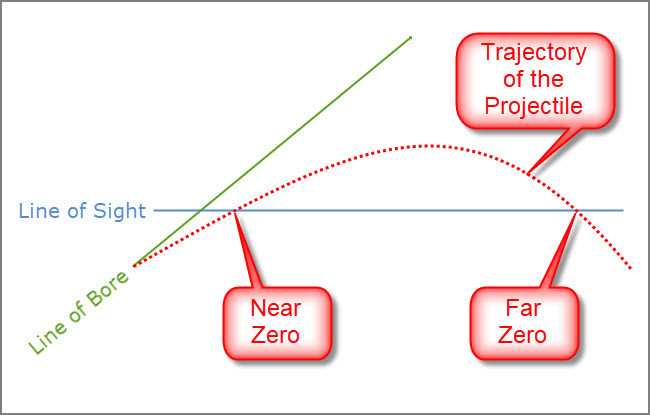
I’ve included this image because I made several references to the near and far zeros.
The take-away here is that the near zero and the far zero have the same point of aim (POA) and should (ideally) have the same point of impact (POI).
Everyone who has read about shooting theory has probably seen some variation of the picture (above) showing how the upwards pointing line of the bore causes the projectile to cross through the horizontal line of sight above it (at the near zero) then, because of gravity, arc over and cross the line of sight(at the far zero) before falling to the ground somewhere downrange.
This simplified and exaggerated two-dimensional picture is theoretically true. But, because of all of the other things that affect projectiles, their path is more like a three dimensional curved cone of water sprayed from a garden hose. A poorly indexed barrel is one of those things that will affect the point of impact.
Do you need to be concerned about indexing?
Depends…
If you hunt and plink at less than 35 yards you will probably not notice if the barrel is (slightly) out of alignment. If you target shoot at a fixed distance, sighting in for that specific distance aligns the sights with the path of the projectile and the fact that the projectile may not traveling in a simple vertical plane a skewed trajectory will not be noticed.
But, if you shoot at variable ranges and especially out to longer distances, the effects of a poorly indexed barrel will show up as a windage change of POI that is not related to the trajectory (gravity). This can be very confusing and frustrating. Depending on where the rifle is zeroed the POA can drift quite a bit as the distance to target changes.
Symptoms of a poorly indexed barrel
I set up most of my rifles for the optimum point blank range and do my initial sighting in at the near zero then confirming by checking the POA/POI at the far zero. Typically for my PCPs, the near zero is around 17 to 19 yards and the far zero is between 38 and 42 yards. Ideally (there is that nasty word again), the POA/POI are identical at both zero points. If I see groups that drift away from vertical in a consistent direction I check my barrel indexing.
A perfect, arcing trajectory is beautiful… drifting pellets are not! Try to setup a shooting session to be able to see the pellets. On my shooting range, with the dark log backstop and the sun behind me I can usually see pellets in flight. An alternative is to paint the inside of the skirt so it is more visible.
Poor indexing will throw the projectile off at some angle (up/down/left/right) relative to the POA with gravity further complicating matters. If you see the POI shift in a linear fashion (say, from left to right on the 9 o’clock/3 o’clock line) as the distance changes then indexing should be tested at various distances.
Sighting in at close range and checking every 10 yards out to 50 yards will give you a visual of the projectile’s flight path showing if it is drifting. A properly indexed barrel will have the POI strung a vertical plane (by distance and gravity) along the 12 o’clock to 6 o’clock line.
What to do?
As with all adjustments, if your airgun is shooting well, don’t mess with it. If you decide to make changes be sure you can restore things to where they were.
If you discover an alignment problem and can’t index the barrel then you can reduce the effects of misalignment by choosing a zero that is at half to three quarters of the range you typically shoot at.
If your rifle allows you to rotate the barrel (or with FX products, the liner) then you can index the barrel to shoot along the 12 o’clock to 6 o’clock” line to eliminate the drift and all will be good!
Setting up for indexing
For indexing, you will need the tools needed to free the barrel and a permanent marker for making reference marks. I use Isopropanol alcohol to clean the oil off where I’m marking the barrel and erase the marker ink (don’t forget to oil the metal afterwards). A bit of silicon grease applied between the barrel liner and the retaining nut reduces the tendency of the nut to turn the liner as it is being tightened. The vise-grips (with heat shrink to protect the metal) offer a positive grip for turning the barrel in its mount.
A notebook for sketches to keep track of where the holes on the target came from and a compass to analyze the pattern is helpful. And a level… because I have bubble levels on my PCP scopes to minimize cant and always level my targets.
Before starting, some prerequisites… the rifle should be well tuned, all hardware checked and tight and the barrel cleaned.
There are a couple of stages to indexing a barrel, to keep things simple and clear I prefer to use a separate (fresh) target for each stage.
A comment about safety… because I will be working at the muzzle end of the airgun I index my airguns alone. It’s safer, with no distractions I can focus on what I’m doing while I repeat the routine (disassemble, adjust, re-assemble, load, shoot and check) multiple times.
The first thing is to find where we are
A reference mark is needed to keep track of the barrel rotation. Here I’ve marked the barrel sleeve and liner at the 12:00 o’clock position with a permanent marker.
Groups are shot at the 12, 3, 6 and 9 o’clock positions – as viewed looking through the scope at the target. Note to self: remember that the 3 is on the left and the 9 is on the right when facing the opposite direction towards the barrel (don’t ask why I need the reminder LOL!).
After each rotation, the barrel and all accessories (shroud, moderator etc.) should be properly installed and tightened before shooting or the testing may not be valid.
In looking at the first target, the shots at 12 are at the sight-in point (pardon the drift – it was quite windy) which is on some arbitrary point relative to the barrel bias.
As the barrel is rotated to the 3, 6, and 9 positions the groups will rotate around the neutral point (the white cross in the picture) of the barrel bias so the pattern of holes can be in any quadrant on the target.
To find the approximate neutral point, draw a line from the 12 o’clock group to the 6 o’clock group and one from the 9 o’clock group to the 3 o’clock group. Then, using this intersection as a reference, center draw a circle through the groups as best you can. It doesn’t matter if the lines are skewed a bit.
This is where the tires touch the road. The group that is farthest from the neutral point (outside the circle) indicates the high point of the bias. We want to index the barrel such that the high point is at the 12:00 o’clock position so that the trajectory of the projectile is in the same plane as gravity.
On this target the high point is at the 3:00 o’clock index. I also shot test groups with the barrel at the 2:30 and 3:30 positions for confirmation.
Re-indexing the bore
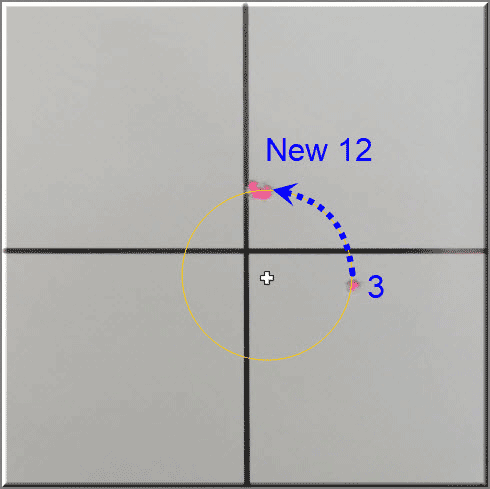
The 3 o’clock re-indexed to the 12 o’clock position.
To re-index the barrel I like to use a fresh target and (roughly) reset the neutral point of the barrel close to the center of the target by adjusting the scope.
I then reshoot the high point of the bias (position 3 in my test) as reference point on the fresh target and proceed to rotate the barrel and shoot to walk the point of impact up until it is above the neutral point of the barrel. For clarity, I’ve just shown the first shot and the last group.
Checking the indexing
The final test is to check that there is no drift.
The picture above is of a series of shots from 10 to 50 yards done in 10 yard increments. The vertical alignment of the impacts shows that the trajectories of the projectiles are aligned with gravity.
We’re done! Now it’s just a matter of sighting in at the preferred range.
Summary
Wow, for something so simple to do it sure took a lot of words to explain! In summary, if you notice a distance-related shift in the POI it is quick and easy to run a check and see if it is indexing related. Determining the bias of the barrel and correcting it takes a bit of patience and an hour or so of time. It’s best to take your time for this kind of tuning.
Being a compulsive tinkerer I don’t need much excuse to test and tweak my airguns to get the best out of them. If nothing else it confirms that all is good and increases my confidence.
Hope this helps!
Hank
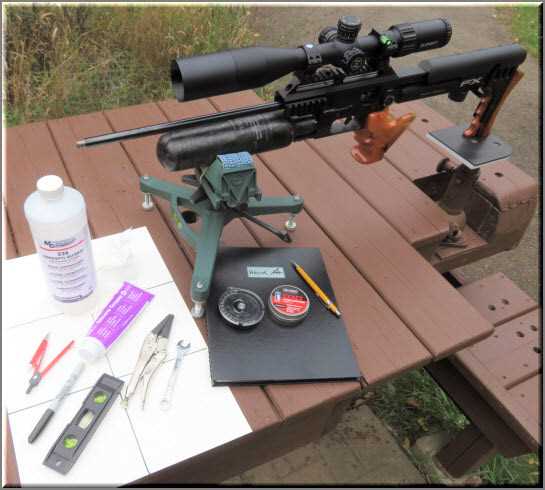


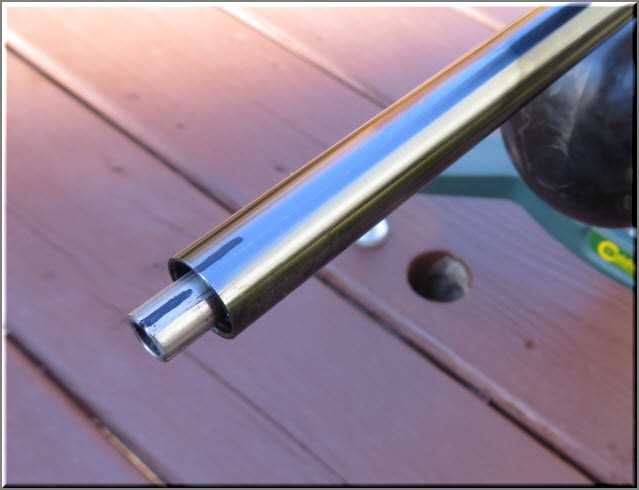
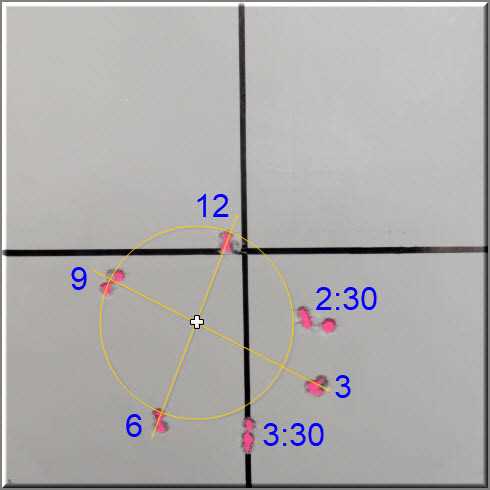
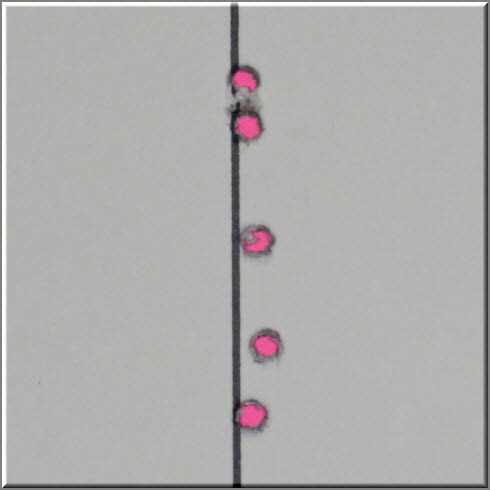
Hank,
Great report, I think?? 75% is way above my comprehension. I’m a simple springer guy.
Does this have to do with the spiralling pellets that I sometime see out of my Hatsan 95 Votex?
I will say that the guys at the range who shoot slugs at 200 yds and have an 8 shot group an inch or less, is pretty impressive. 55 yds max for me.
-Y
The spiraling is more related to velocity and twist rate (I think). Try a heavier pellet.
Yogi,
Pellet spiraling is something else. Sub one inch groups at a 100 yards impressive – at 200 yards it’s beyond awesome!!
The whole beauty of springers is their simplicity, I really enjoy mine and shoot them daily. Shooting one out to 55 yards is a real challenge – just as impressive as 200 yard shots with a PCP.
Hank
“Wow, for something so simple to do it sure took a lot of words to explain!”
Hank,
Excellent report! I think you used the right amount of words; on a subject like this, I think “more is better.” 🙂
And I think this relates to more than air rifles. I’ve been looking at some rifled adapters for my 12-gauge (like .22LR and .45 Colt caliber); I watched some videos, and the first thing I thought is, “even with 10 inches of rifled barrel, and external sights, how in the world can these things get any accuracy unless they are inserted the same way every time?” (i.e. indexed). It would seem to me that any time you put a rifled tube inside another tube, unless it’s indexed and locked in the same way each time, you are looking for trouble…or inaccuracy. 😉
Again, I think this is a great guest report and I’m looking forward to your future ones!
Cheers,
dave
Dave,
Glad you liked it! I’m working on another one for you 😉
H
Excellent! 🙂
Vana2,
TREAT!
Thank you Hank for another superb guest blog!
shootski
You’re welcome shootski!
What an interesting article on barrel rotating effects. Vana2, I am impressed that you can demonstrate what your airgun does. I struggle to get mine to shoot to point of aim at any distance. Yes, I would probably miss at point blank too. 🙂
Theoretically, to apply this so-called ‘indexing’ procedure to my airguns, none of which appear to have rotating barrels, I would just rotate the whole gun, eh?
And when people ask why I’m holding my rifle upside down (if that’s where it shoots closest to the vertical), I could just say “well, I like trick shots”… 🙂
3hi,
I probably need to practice some “trick shooting” myself.
“I struggle to get mine to shoot to point of aim at any distance.” That little toy army truck you shot up might disagree with you. ;o)
>>> why I’m holding my rifle upside down <<<
Hihihi,
Thanks for that "trick shot " image – made me laugh!
Hank,
Superb explanation of indexing. The major issue many will have is whether the barrel can be indexed. Most barrels cannot, The high end FX airguns allow such and most of the AirForce airguns can be indexed, but most of the lower priced PCPs and almost all of the sproingers cannot. Many of the PCPs have the transfer port drilled directly into the barrel and most of the sproingers have barrels that are pressed into the pivot blocks.
Now, if we are fortunate enough to be able to rotate the barrel and not forced to do “trick shots” this is most definitely the thing to do. I can see my “new” Talon SS going through this proceedure. I might even give it a try with my Texan, although the “loading tray” may be an issue.
P.S. If my rememberer is working properly, I think I had this issue with my HM1000X. I wish I had read this earlier. I did not think about this.
RR,
Yeah, on many airguns the barrels are fixed. Still, I think it is important to be aware of barrel bias and to test for it to see how it affects accuracy if you shoot at longer ranges.
Hank,
It is most important. It helps you to “know” your air rifle.
RidgeRunner,
Yes the location of the Transfer Port is the first thing that typically stops barrel indexing. There are barrels that slide into the receiver that are held into place by set screws (grub screws) that have flats machined into them also but that need not stop indexing efforts even if the muzzle has a flat to orient a front sight that can be overcome.
On break barrels some of them have the ability to index the barrel e.g. HW30S and others no doubt.
On my DAQs the barrels are threaded and can be Timed (same as indexed) and then a Witness Mark can be made on barrel and Reciever to allow return to same orientation as needed.
As I have been preaching to the choir there are a host of things the (MOST) airgun manufacturers are not doing to improve precision and I blame the fact that the vast majority of buyers are ignorant of all these factors.
Then again another thought comes to mind…the search for cheap pellets, cheap airguns, and cheap scopes, and cheap, cheap, cheap!
I have scattered some bread crumbs…will the birds be cheeping?
shootski
Shootski,
With all the “cheeping” (LOL!) I am reminded that it was not that long ago (from an old guy’s perspective) that there was little choice (in brand or quality) of airguns or pellets or scopes and accuracy was what it was. We just had to make due and work within the limitations.
Amazing where the airgun technology is now! Makes me think we have a lot to sing about 🙂
H
Hank
Nice report. In golf it’s called spine finding. Golf club shafts have seams where the rolled metal sheet is joined. This is the spine. The idea is to attach the clubhead with the spine in line with the POA of the clubface. The spine can be either on the front side or backside of the shaft. If it is located anywhere else the shaft will flex left or right and adversely affect the ball’s flight.
Deck
Deck,
Golf clubs – not a golfer and didn’t realize that spine was a consideration, I’m not surprised though. Spine finding is important for when I make arrows and fishing rods, golf clubs are the same kinda thing.
Fantastic topic! And a great explaination of how to check and fix . I can see a few hours at the bench with my Condor SS in my future.
rk,
Glad you liked the blog!
…Like you really needed an excuse to shoot your Condor eh? 😉
H
I had always understood barrel indexing as explained in this post, that is, as related to bore concentricity but someone recently told me the effect was due to how the projectile exits the lands. He said that to index a barrel that can’t be rotated, gunsmiths push the crown back so that the lands and grooves are now oriented differently at the muzzle. I haven’t looked into this but it seems like it might make sense, especially as regards FX liners, which aren’t bored out.
That is an interesting corollary to a fine report. Thanks Hank and thanks Rambler.
Hopefully, not too many springer barrels will be chopped….
Rambler,
Interesting approach to modify the crown to true up the projectiles’ path. Sound like it would take some serious time and tinkering to get the right correction.
Know that a poor crown can affect the stability of the projectile but (unless it was really knocked way off axis) it wouldn’t change its path much. Didn’t think it would have enough “leverage” to do that.
Thanks! Something new more to ponder 🙂
H
Rambler,
“I had always understood barrel indexing as explained in this post,” I won’t be changing my opinion on barrel indexing as we understand it and I don’t think that gunsmith is showing a better solution to the barrel whip (as shown in ultra highspeed photography) that the 12 O’Clock index is ultimately based on. I certainly think that the Crown has a potential impact on precision but it pales in comparison to the amount of deviation that can be eliminated by properly indexing the barrel to the harmonic whip.
As an added point bullet/pellet base inconsistency is of much greater concern than a stable crown.
Over the years I have observed that the priority should be to eliminate the most changeable variables first.
Of course that obviates reading the WIND and the BASICS of shooter skills as the very first things most of us need to work on.
A blown wind read shows on the Target before any other fault.
Just my informed opinion supported by well over a half century of the pursuit of accuracy in any number of projectile launching systems..
shootski
Shootski
There are quite a number of things that can influence the potential accuracy of any projectile launching device. Tho many may well be interconnected,, it would seem prudent to approach each on it’s own when seeking improvement. Some may be more important than others,, but like they say,, “Ya gotta start somewhere”.
About the shortening of barrels to change their characteristics,, if it were simply to change where the rifling ended,, it would seem counterproductive as with a 1 in 14 twist, wouldn’t one need to shorten it just under 14 inches in order to have explored all the possible places a particular land or groove exited?
Just a random thought from a mind that seems more random every year!!
Ed
edlee,
I have never worried myself over the Alpha & Omega of Barrel Lands; nor about the Grooves for that matter.
Ed, I do however agree with you on the Dickensian wish for more!
Never enough time to shoot for darn sure!
shootski
Very good comments Shootski. I have the suspicion that the whip dynamics have much more influence on POI and ‘cant’ that a small change in the crown.
Once I saw a long distance (400 y) FA shooter changing the point of impact by adding duct tape close to the muzzle. I left the range and he still was tinkering so I don’t know the final conclusion.
Henry_TX,
There are many folks in the airgun community that don’t subscribe to barrel whip in airguns. It seems to be a topic for a many U Tube videos and “expert” posts on various blogs. Sadly they typically include comments about the projectile leaving the muzzle before they can visually detect the whip. They also subscribe to the argument that airguns don’t have the chamber/barrel pressure spikes that firearms experience.
Even folks in the PB side of shooting find the topic controversial based on typical high speed consumer video and not Lab level ultra high speed video with sensor data included.
Hanks work and applicability to airguns is clearly evident in a well structured test demonstration of the potential of barrel indexing regardless of the root cause of the POI displacement.
shootski
Vana
Another informative guest blog. Please know that they are well enjoyed by me, even if I never put one of them to use. At least I will have it stored,, “up there”,, with all the rest of my eclectic mix of bits of wisdom. With luck, I may even recall it when I actually need to make use of it ( that last is hit and miss of late).
As the kid in the Dickens story said,, ” Please sir,, may I have more”.
Ed
“…if your airgun is shooting well, don’t mess with it.” Best takeaway for FM from this interesting, clearly-written and informative post. He’s learned the hard way that, if it ain’t broke, don’t fix it.
FawltyManual,
Hank was honest in his choice of the title of his Guest Blog. Seems to me you only need Sub Iguana kill zone accuracy to make you a very happy shooter.
Contentment is what we should all be shooting for…what passes for happiness is way overrated in my book.
shootski
Your assessment is correct, Shootski. Still, FM enjoys reading and learning about all things technical. Sometimes the knowledge actually comes in handy. As for shooting distances, would love to do more 50-yard targeting but have to work with what we’ve got. One of these days ole FM is going to take one of the PCPs and maybe a springer out to an outdoor range and just challenge himself to do better than side-of-the-barn MOA.
Being content is good.
Thanks Hank, a very informative and useful report. Really well done.
Henry
Thanks Henry, glad you liked the blog!
H
Hank,
You teased us with your comment yesterday. You did a fine job describing the process of indexing of barrels in today’s guest blog. Barrel indexing another factor in trying to understand why we’re seeing a POI shifting always in the same direction with changes in distance. The image of comparing a hose nozzle and its cone of spray to the way that a pellet can exit a barrel was a good one. You get one of infinite possibilities.
I see from the other’s comments that indexing may or may not be done on many air rifles for various reasons. So if we have an indexing issue with an airgun, can we make changes to account for it, or at least improve it?
Bending the barrel seems like it would help if you can’t twist a mounted barrel. Else you have to develop a chart for elevation and windage settings for changes in shooting distance.
One thing that B.B. described in a past blog is the specter of scope rails that are not in line with the bore. This also creates sideways variation with distance when using a scope. But the POI switches sides before and after the zero distance.
It can tax the brain to sift through the variables and understand the source of the problem when things don’t go as expected in this hobby. But that is what keeps it interesting. What a fine can of worms you’ve opened for us, Hank! As always, your excellent guest blogs are very much appreciated. Thanks for the brain fodder.
Will
Will,
Per the title of the blog “In Pursuit of Sub-MOA” barrel indexing is just one of the many variables that affect accuracy. The little variables add up to become a big concern so, to really get the best accuracy you can you need to minimize what you can. Individually, depending on your equipment and what you are doing, these variables may or may not affect your shooting.
Barrel indexing is a problem if you are shooting an accurate rifle at long distances (50 yards plus), at small targets and at constantly changing ranges.
A prime example would be the guys who pest pigeons or ground squirrels at 100 to 200 yards. An indexing error would throw them right off target and would be very difficult to compensate for. Rabbits at 25 yards would not be a problem though because of the range and size of the target, an indexing error would not be noticed.
So… if the hardware and software (the rifle, sights and shooter) is shooting 2 inch groups at 50 yards, a half inch shift in POI (25% error) is not going to be noticed where to someone shooting half inch groups this represents a 100% deviation.
If your rifle has an indexing error and you can’t rotate the barrel then an option is to setup the sights to minimize the effect within your shooting range. Put the POA half way between the POI drift over the range you shoot at. So if you have a one inch left error at 60 yards then set the POA to half inch and split the difference.
If you hunt/pest at long range the and indexing error is a concer. If you typically shoot at less than 50 yards the error would have to be very bad to be a problem. If you target shoot at fixed distances, sighting in at that distance automatically compensates for errors and misalignment in the hardware.
Hope this helps.
Hank
Vana2,
Hank I’m going to add a feature to your Guest Blog hope you don’t mind.
So what Hank has done is give a superb guide to fixing the indexing of a barrel; but he has also provided another item to put on you decision tree for that next airgun purchase decision. If as Hank points out you plan to do pesting, Field Target, or hunt at longer ranges you should have a NO BUY on an airgun with no way to INDEX the Barrel!
shootski
Hank,
Thank you for a great report! It is nice to have the possibility to turn the barrel just like that. Usually not the case :/ But I liked the systematic of this test!
Question – paint the skirt of a pellet? How and what to use for this? What about painted accuracy?
I had many ideas how to make the pellet flight be visible… nothing really helped so far. It is not so easy as in firearms.
tomek,
It’s the inside of the skirt that is painted with a dab of something that contrasts with the background so that is more visible in flight.
It’s something that you would use when tuning and testing for stable flight, not for daily use.
I’m lucky that the lightning on my shooting range is such that (in the evenings) I can usually see the pellet through the scope (at 24x) if I’m watching for it. When I’m focused on the target I’ll only notice the pellet (as a flicker of light reflected off the back) if it shows some instability.
Glad you liked the report!
Hank
Hank,
I observed many times pellets flying, just as you said. Have sometimes same shooting conditions with the sun going down behind me. It is amazing to observe something like this at 50yards. I always wanted to observe the whole flight, to put something which is burning bright under the skirt and shoot it in the night. Never thought just paint it for more contrast during the day time shooting. Thanks for it, I will try it definately.
Hank,
No big words, just a big THANK YOU for this real educative post, a well systematic and logic approach, very well written.
Great post, again thank you.
You’re welcome Papa Schultz!
Glad you liked the report!
Hank